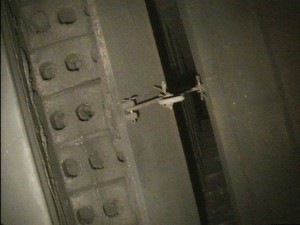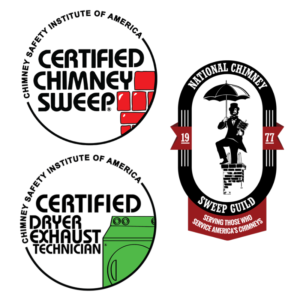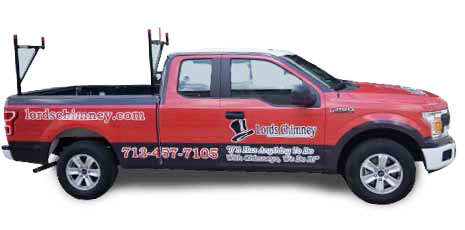Spring has officially arrived, and with the warmer temperatures and longer days come new babies for many different kinds of animals. Unfortunately, many birds and small mammals may view your chimney as the perfect place to build a nest and raise their young. While many animals and their nests can be safely and humanely removed if they get into your chimney, one cannot: the chimney swift.

About chimney swifts
A chimney swift can be recognized by their size, color, movements, and sounds. Chimney swifts are small birds with narrow bodies and long wings. While up close they are a brown-gray color, they may appear black when backlit against the sky. Swifts fly and twist side to side erratically, and have a distinct high pitched chirp.
Although chimney swifts spend their winters in South America, they migrate north to the eastern United States and Canada each spring to nest and raise their young. According to the Cornell Lab of Ornithology, “Their ability to travel over long distances and through a variety of habitats exposes them to a wide range of microorganisms.”
Chimney swifts got their name because of their unique ability to build nests that stick to the side of slippery flue tiles. While swifts traditionally prefer to nest in hollow or dead trees, the increase in size of cities, suburbs, and agricultural areas has forced them to adapt.
Removing chimney swifts
If birds take up residence in your chimney, your first reaction may be to have them removed as soon as possible. Unfortunately for many homeowners, chimney swifts and several other species of migratory bird are protected under the Federal Migratory Birth Treaty Act. This law makes it illegal for anyone to remove or destroy chimney swift nests, eggs, or hatchlings, with severe fines and penalties for anyone who violates the law.
Luckily for those dealing with an unexpected nest of chimney swifts, the birds have a relatively short nesting period. Chimney swifts can lay, hatch, and raise their young in about six weeks. Likewise, as they nest in the spring and summer when fireplaces are not typically in use, the presence of a chimney swift nest of often little more than a minor inconvenience.
Keeping chimney swifts out
Because chimney swifts cannot be removed once they have taken up residence in your chimney, the best thing homeowners can do to prevent them is to have their chimney regularly inspected. A chimney inspection can ensure that there are no areas for chimney swifts to enter through, such as a damaged chimney cap.
Likewise, because chimney swifts are migratory they tend to return to the same nesting ground each year. Because of this, if you have chimney swifts find their way into your chimney it is extremely important to have the chimney inspected and repaired after they leave. If not, you may find that your chimney becomes an annual summer home for a family of chimney swifts.
If you think you have birds in your chimney, contact Lord’s Chimney today. Our expert technicians will be able to find out if they can be removed as well as help prevent them from getting in again.
Gas fireplaces make a beautiful addition to any home and are an increasingly sought after feature for homebuyers. Valued for their beauty, functionality, and ease of use, more and more homeowners are converting their existing open hearth fireplaces to gas. However, what many may not realize is that their new gas fireplace is missing a required component – the damper stop.
Although many homeowners may not know what a damper stop is, they are a necessary part of a gas fireplace. Unfortunately, many homes with gas fireplaces – especially those that were not professionally installed – may be missing this important piece.

What is a damper stop?
A damper stop is a piece of metal designed to ensure that the flue of a gas fireplace always remains partially open. With a traditional hearth fireplace, the damper is opened or closed when the fireplace is in use.
While gas fireplaces also need the flue to be open while in use, there is often no mechanism to close it; instead, the damper is simply left partially or fully open when the gas insert is installed. However, leaving the damper open at installation does not ensure that the damper will stay open forever. Strong winds, house settling, or other damage to the flue or damper can cause the damper to close.
Because of this, damper stops were designed to be installed as a way to keep the damper permanently open. Although they are required, some homes with gas fireplaces – especially those that were self-installed by previous homeowners or untrained installers – may not have them.
Dangers of a missing damper stop
A damper stop may seem like an insignificant piece of the gas fireplace. However, it is a specially designed safety precaution that can help protect your family, namely against carbon monoxide poisoning.
Carbon monoxide is an odorless, tasteless, colorless gas that is often called the “silent killer” because it is so difficult to detect. When the damper is open, carbon monoxide is able to safely travel up the chimney and out of your home. However, if the damper is closed this deadly gas can back up into your room, affecting the health and safety of you, your family, and your friends.
How to identify a damper stop
With a traditional hearth fireplace, it is easy to tell if the damper is open or closed; if smoke back flows into a room when the fireplace is in use, the damper is closed. Gas fireplaces, however, do not produce smoke, making it much more difficult to tell if the damper is open or closed.
Missing damper stops are most frequently identified during home inspections; however, they can be easily missed, leading homeowners to believe that there is nothing wrong with their gas insert or fireplace.
To make sure that your gas fireplace has a damper stop that is correctly installed, contact Lord’s Chimney to schedule a chimney inspection. Our trained chimney sweeps will be able to inspect your chimney and fireplace to determine whether or not your gas fireplace has a damper stop; if it is missing, one can be installed. To make sure your chimney is up to current safety standards, contact us today!
If you walk down the aisles of your neighborhood big box home improvement store, you are bound to see a wide variety of products designed to help homeowners clean and maintain their fireplaces. While some of these products can be useful, they should not be used to replace regular annual chimney maintenance by a certified chimney sweep.
One such product that our customers regularly ask about are “chimney cleaning logs”. Sold for less than $20 at many home improvement stores, chimney sweeping logs advertise their ability to significantly reduce creosote buildup in the chimney. Because of this, some homeowners purchase and burn these products as their only form of chimney maintenance, patting themselves on the back for saving money on a chimney sweep.

Despite their advertising claims, these logs are no replacement for a professional chimney cleaning. Although they may be able to remove some creosote buildup, there are a number of ways that they are deficient at maintaining the health and safety of your fireplace system.
Why loosening creosote is just part of the job
The primary purpose of a chimney cleaning log is the removal of creosote; the smoke from the log loosens the creosote and causes it to fall down the flue and into the firebox, where it can be safely swept up and removed.
In theory, this is an excellent system. Unfortunately, the reality leaves much to be desired.
Most flues are not a straight vertical line between your firebox and the top of the chimney. Depending on your fireplace’s location, your flue may have one of more curves and bends in it. When this happens, the loosening of creosote by the chimney cleaning log merely causes it to fall and accumulate in the bends of the flue. This may not only block the flue, but can also create a significant fire hazard. Even fireplaces without curved flues may wind up with the majority of the creosote trapped on the smoke shelf, which can be difficult to access and clean without proper training.
A chimney cleaning log is no substitute for a chimney sweep
While a chimney cleaning log may be useful in loosening creosote, it is no substitute for the services performed by a certified chimney sweep.
“I usually tell people using one of those logs instead of having your chimney cleaned manually is like chewing Dentyne instead of brushing your teeth,” said Allan Bopp of Bald Eagle Enterprises. “It may help a little, but it’s a poor substitute for the real thing.”
Likewise, a chimney cleaning log has no way to know or tell you if your chimney is damaged in any way. There are a number of hidden issues such as cracked flue liners, decaying masonry, or damaged chimney caps or crowns that can only be spotted by a sweep during a chimney inspection. Because many of these chimney issues do not affect performance, you may have no idea there is even an existing issue.
Don’t trust the health of your chimney or the safety of your family to a $20 log bought at a big box store. Instead, have an annual chimney sweeping and rest assured that you can safely use your fireplace for the rest of the year. Contact Lord’s Chimney today to schedule an appointment!
As a homeowner, there are lots of things around your home, both inside and outside, that need to be regularly maintained. And let’s face it – it’s easy to get so overloaded with household to-do lists that sometimes some of the most important places get overlooked.
We’ve noticed that fireplaces and chimneys tend to get thrown into this overlooked category since they are only used for a portion of the year. Sound all too familiar? Well, don’t burn yourself out figuring out how you’ll fit in yet another job. Simply give our experts a call to handle it all!
Chimney Inspections & Sweepings
Annual chimney inspections are essential when it comes to keeping your system standing strong for the long haul. All kinds of hidden dangers could be lurking and putting your home at risk, and it takes the trained eyes of a pro to spot and resolve them. Oftentimes, what homeowners think of as no big deal (even something as seemingly minor as a broken tile or brick) are actually quite dangerous.
 When it comes to chimneys, the sooner any issues are spotted and addressed, the better. If there is a crack, it will only continue to grow. If mold shows up, it will only spread. If things aren’t heating correctly, this will only continue, costing you more to operate the appliance and putting your home at risk.
When it comes to chimneys, the sooner any issues are spotted and addressed, the better. If there is a crack, it will only continue to grow. If mold shows up, it will only spread. If things aren’t heating correctly, this will only continue, costing you more to operate the appliance and putting your home at risk.
That’s why we urge all of our customers to book inspections at least once per year and always before kicking off your burning season. During these, our sweeps will look for any flaws, build-up, and imperfections, and then suggest any further maintenance, like sweepings or repairs, as necessary.
And what’s the importance of a chimney sweeping? To start, they remove any build up, excess debris, and creosote, which is the main cause of chimney fires. And apart from being fire hazards, blockages can lead to smoke in your home, carbon monoxide poisoning, and a lack of efficiency.
Repair & Restoration Services
Now, chimney sweepings and inspections are an important part of chimney maintenance, but they’re still just only one part of the equation. That’s why we offer a wide range of chimney, masonry, and venting services and repairs, all of which allow us to better serve our customers and meet all of their chimney and fireplace needs.
If your fireplace or chimney is worn down after years of use, we can help restore it to its former glory. Our fireplace restoration services can fix every part of your chimney, from the chimney cap at the top to the firebox at the bottom. Some of our many services include tuckpointing, leaky chimney repairs, chimney pressure washing, relining services, wildlife removal, troubleshooting, and even replacements or facelifts.
Not sure where you stand or what you need? Give us a call! We’d be happy to answer your questions and get you where you need to be.
Need Dryer Vent Services?
In addition to our chimney services, we can also clean dryer vents, as well as assist with installation and re-routing. Even if you regularly clean your lint trap, lint will still accumulate in your dryer vents and hoses over time, which can then create clogs and fire hazards. In fact, dryer-related issues cause thousands of house fires every single year. This one service well worth investing in.
Clean dryer vents can also help your dryer run more efficiently, wasting less energy and resulting in dryer clothes after each load. This saves you money month to month, and keeps your dryer and clothes from experiencing excess wear, too.
We’re Trusted Throughout Houston
At Lord’s Chimney, we have been proudly providing the greater Houston area with chimney, fireplace, masonry, and vent services for years. If you’re experiencing chimney issues, there’s no better crew to trust!
 Why do so many turn to us time and time again? Well, for one thing, we make education a priority. We’re certified with the Chimney Safety Institute of America (CSIA), members of the National Chimney Sweep Guild (NCSG), and maintain a long list of certifications, associations, awards, and 5-star reviews. One look at our credentials and it’s clear – we take what we do seriously!
Why do so many turn to us time and time again? Well, for one thing, we make education a priority. We’re certified with the Chimney Safety Institute of America (CSIA), members of the National Chimney Sweep Guild (NCSG), and maintain a long list of certifications, associations, awards, and 5-star reviews. One look at our credentials and it’s clear – we take what we do seriously!
In the end, when you hire a sweep for your chimney inspections, sweepings, and more, you deserve to work with someone you can trust. If your sweep is associated with reputable organizations, experienced, and has a strong relationship with the community it serves, these are all solid signs that they’ll have your back throughout it all. When you hire us, we’ll treat you and your fireplace with respect!
Keep Your Home Safer By Working With Us
A clean and well-maintained chimney and fireplace doesn’t just help with efficiency… it also ensures your home stays a safer place to live season after season. Stay out of harm’s way by reaching out to our highly trained and qualified staff today. When you work with Lords Chimney, you work with the best!
During the cold winter months, many families use their fireplaces as a gathering place, sitting together and enjoying the warm flames. But even as your fireplace is keeping you warm inside, the cold temperatures and winter weather could be damaging your chimney outside.
Winter weather conditions are notorious for destroying chimneys and causing existing damage to deteriorate even faster. Snow, ice, and freezing rain can wreak havoc on a chimney system, even one that is in seemingly good condition. Because of this, it is extremely important get a chimney sweep and inspection before the weather gets any colder. This ensures that your fireplace and chimney are safe to use and have not been damaged during the past year.

Water damage
The main way that chimneys are damaged during the winter months is due to water damage. If water is able to enter a chimney structure, it can cause a multitude of issues including rusting pieces of the flue to damaging the masonry. Pinpointing how water is entering a chimney can often be difficult as there are many different places that can cause leaks. The trained technicians at Lord’s Chimney are leak resolution experts who can find and fix the water entry before it causes further damage.
Below are three of the most common causes of water entry in a chimney system:
Damaged chimney cap: Chimney caps cover the top of the chimney itself, keeping the water from rain, sleet, and snow from getting into a chimney. Improperly installed, ill-fitting chimney caps, or damaged chimney caps can allow water to enter the fireplace system. Damage to the chimney cap is often difficult to spot because they cannot be seen from the street.
Leaky flashing: Flashing is the metal band that connects the chimney to the roof structure. Nail holes, loose caulking, poor materials, or general wear and tear can all cause flashing to lose its waterproof seal. Damaged flashing can cause damage to both the chimney and the roof, which is why it is vital that it is properly installed and maintained.
Masonry damage: Although bricks are made to be porous, absorbing too much water can be detrimental. During the freeze/thaw cycle, water in the brick expands as it freezes, causing additional cracks and damage. As it thaws, this creates more space for additional water entry and the cycle continues, eventually causing the brick to break apart and crumble.
Preventing chimney damage
The best way to prevent damage to your chimney during the winter months is through preventative maintenance. An annual sweep and inspection allows any issues to be spotted and resolved before they become major problems. This can save both time and money as well as preserve the safety and structure of your safety.
Lord’s chimney can also apply a special waterproofing to bricks and mortar. The ChimneySaver sealant retains the porous quality of the bricks, letting toxic gasses pass through without letting moisture in. ChimneySaver also allows trapped moisture to evaporate, preventing deterioration, freeze/thaw damage, and the need for expensive masonry reconstruction.
If you have questions about the health of your chimney system, need to schedule an annual sweep and inspection, or would like more information on ChimneySaver waterproofing, contact Lord’s Chimney today!





 When it comes to chimneys, the sooner any issues are spotted and addressed, the better. If there is a crack, it will only continue to grow. If mold shows up, it will only spread. If things aren’t heating correctly, this will only continue, costing you more to operate the appliance and putting your home at risk.
When it comes to chimneys, the sooner any issues are spotted and addressed, the better. If there is a crack, it will only continue to grow. If mold shows up, it will only spread. If things aren’t heating correctly, this will only continue, costing you more to operate the appliance and putting your home at risk. Why do so many turn to us time and time again? Well, for one thing, we make education a priority. We’re certified with the
Why do so many turn to us time and time again? Well, for one thing, we make education a priority. We’re certified with the 